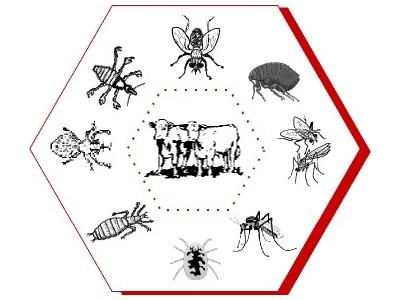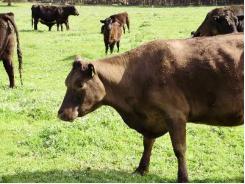Diseases of Cattle: External parasites

Horn flies, face flies, stable flies, ticks, lice and mites are the major external parasites in beef cattle.
Horn Flies are about half the size of house flies and are dark gray. They are blood-sucking flies that stay on the shoulders and backs of cattle almost continuously. During extremely hot weather or when it rains, they may move to the protected underside of the animal. When disturbed, horn flies will fly up in a swarm but they will return to the animals almost immediately. A horn fly leaves the back of a cow or calf only to lay eggs in fresh manure. They suck blood from the host 24 hours a day. Individual flies pierce the skin with their short, tube-like mouthparts 20 to 30 times per day to ingest a small amount of blood. Their feeding activity is painful and annoys the animals, as well as causing some blood loss.
There are many effective options to keep horn fly numbers below the 100 fly per animal treatment threshold. Cost, convenience, and herd management practices, such as grazing rotation, can be considered when designing a control program that fits best. Backrubbers allow cattle to treat themselves while loafing and scratching. Dust bags are most effective when used where cattle have to pass under them daily to get to water or mineral. Feed additives target horn fly maggots breeding in fresh animal manure. High pressure sprays can be used to treat cattle thoroughly and inexpensively on a per head basis. An insecticide bolus is a large pill-like formulation that is given to the animal with a standard balling gun. Insecticide-impregnated cattle ear tags release small amounts of an insecticide which are distributed over the animal during grooming or rubbing. Pour on insecticides are ready-to use formulations that are applied in measured doses to animals based upon body weight.
Face Flies closely resemble house flies. Face flies cluster on the faces of cattle and feed on secretions from the mucus membranes of the eyes, nose, and lips. Face flies do not suck blood. They do irritate the surface of the eyeball and carry and spread bacteria and viruses that contribute to pinkeye problems. They spend only a small portion of their life on cattle which makes them more difficult to control than horn flies.
Stable flies are sometimes called biting house flies. The look very much like house flies. They feed primarily on legs and lower abdomen of cattle. The mouth parts penetrate the skin and allow them to engorge on blood two to three times a day depending on the weather. Once full they move to a resting place, usually in the shade, to digest the blood meal. The blood loss and pain associated with the bite of stable flies results in substantial economic loss.
Ticks cause blood loss, discomfort, and spread diseases like anaplasmosis. Tick control is extremely difficult in areas with high tick populations. High concentrations of ticks usually occur in brushy pastures and woodlands so habitat management is an important part of tick control. Control on cattle through persistent use of approved pesticides is achieved by spraying, dipping, ear tags, pour-ons, dust, and backrubs. A good residual insecticide is necessary to prevent infestation.
Lice cause skin irritation and itching. Both biting and sucking lice infest cattle. Infested cattle can experience reduced appetite and appear unthrifty.
Lice reside entirely on the host cow. Lice are present on cattle year around but increase in numbers in winter. In spring most parasites are lost with the winter hair coat. Lice control is most important in the fall and early winter when the lice populations increase. Treat with approved products. Treatment needs to be repeated in three weeks to kill hatching lice since most insecticides do not successfully kill eggs. Sprays and pour-ons are common methods to treat cattle lice.
Mite infestation is called mange in cattle. A serious form of mange is called scabies. Scabies is caused by sarcoptic and psoroptic mites and must be reported to the disease control authorities. A less severe mange is caused by chorioptes, demodex, or psorergates mites. Mites are spread through close contact. Cattle infested with mites suffer hair loss and a thickening of the skin. Severe infestations can weaken cattle and make them vulnerable to diseases. Scabies can result in severely debilitated animal. Control of mites is difficult because mites burrow into hide. Injectable products or pour-on products with systemic activity work to control mites best. As with lice, a second application is necessary in two to three weeks to kill newly hatched mites.
Related news
Tools

Phối trộn thức ăn chăn nuôi

Pha dung dịch thủy canh

Định mức cho tôm ăn

Phối trộn phân bón NPK

Xác định tỷ lệ tôm sống

Chuyển đổi đơn vị phân bón

Xác định công suất sục khí

Chuyển đổi đơn vị tôm

Tính diện tích nhà kính

Tính thể tích ao



 Diseases of Cattle: Internal parasites
Diseases of Cattle: Internal parasites  Diseases of Cattle: Infectious bovine rhinotracheitis
Diseases of Cattle: Infectious bovine rhinotracheitis